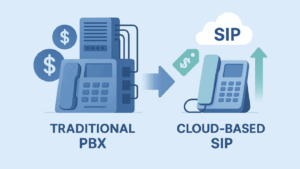
Redefining Communication for Small Businesses: The Impact of VoIP Telephony on Efficiency and Cost-Savings
Telephony has undergone a dramatic transformation over the last few decades. Around the turn of the century, there was a radical paradigm shift away from traditional phone systems for businesses and toward more advanced technology. Businesses knew they needed modern, unified, and more comprehensive features to stay competitive. The VoIP telephone was just the beginning.
Traditional phone systems were costly and inflexible, making it challenging for small enterprises to keep up with evolving customer demands and operational needs. As virtual and hybrid workspaces become the norm, VoIP telephony and the associated systems available through cloud technology are more than just a convenience. They are a necessity that enables small businesses to communicate more efficiently, collaborate seamlessly, and save significantly on communication costs.
By embracing VoIP, small enterprises can compete effectively, improve customer interactions, and position themselves for growth in an increasingly digital world.
A New Way To Do Business
In 1994, telephony changed forever with the world’s first completely free VoIP calling option, and by the mid-2000s, the technology had advanced to include video calling, VoIP telephone applications, chat, conference calling, and unified communications (UC) platforms that enabled seamless access to multiple business collaboration software suites.
Related: Scaling Your Small Business: How VoIP Solutions Drive Efficiency And Competitive Advantage
Because VoIP requires no specialized hardware other than IP-enabled devices, anyone with an internet connection has access, meaning that reaching new customers, nurturing your existing client relationships, and even expanding into new regions is easier and more accessible to companies of all sizes than ever before.
VoIP telephony has enabled businesses to radically expand their capabilities, streamline their operations, and set new goals that were previously out of scope due to limited technology and tight budgets. It allows even small businesses to leverage the same leading-edge tools that larger corporations already had access to, effectively leveling the playing field. Let’s review some of those advantages.
Unified Communications (UC)
VoIP technology seamlessly integrates with Unified Communications platforms, consolidating various communication channels into a single interface. This integration enhances collaboration by enabling video conferencing, instant messaging, and file sharing among team members. A small design studio, for example, can use UC to streamline project discussions and file sharing, improving overall project management and client communication.
Enhanced Communication Features
VoIP offers a wide range of advanced communication features that can improve small business operations. Features like call forwarding, voicemail-to-email transcription, and auto-attendant make communication more efficient. For instance, a small law firm can use voicemail-to-email transcription to quickly review and prioritize client messages, ensuring a prompt response to urgent matters.
Geographic Flexibility
VoIP telephony allows small businesses to establish a local presence in different geographical locations without physically setting up offices there. By obtaining virtual phone numbers for specific regions, companies can attract customers from diverse locations. For instance, a small travel agency can have virtual phone numbers in popular travel destinations, making it easier for clients in those areas to inquire about vacation packages.
Data and Analytics
VoIP systems provide valuable data and analytics on call volumes, call durations, and customer interactions. Small businesses can use this data to gain insights into customer preferences and improve their communication strategies. For example, a small restaurant can analyze call data to determine peak reservation times and optimize staffing accordingly.
Disaster Recovery
VoIP technology offers built-in redundancy and disaster recovery capabilities. In case of network disruptions or emergencies, calls can be automatically rerouted to backup locations or mobile devices, ensuring uninterrupted communication. This is particularly crucial for small businesses that rely heavily on customer calls for bookings, appointments, or inquiries, such as a medical clinic or a hair salon.
Mobility
Anywhere with an internet connection is a workspace with VoIP. Whether your workforce is at a client location, a field office, at home, or a worksite, your teams have access to each other and your clients have access to the help they need. This mobility empowers companies to tap into a global talent pool and hire remote workers, reducing office space costs and increasing productivity. A small consultancy firm, for instance, can have consultants working remotely from various locations, providing clients with timely services without geographical constraints.
Flexibility
VoIP brings people together regardless of physical location. With UC, they can not only converse, but they can collaborate, create, review, edit, and present. If you want to move your headquarters to another location, you don’t have to worry about the expensive installation of phone lines or the lead time required to get them. You have complete flexibility to do business from any location, limited only by your access to broadband internet.
Scalability
One of the most attractive features of business communications based on VoIP and SIP technology, particularly for small businesses, is the ability to scale services and features to match your business cycles. As call demand increases, you can easily scale up. During slower periods, you can scale back down with a simple change in your online control panel.
Security
Your business communications are more secure than ever. The technology incorporates leading-edge security such as encryption and intrusion detection. When choosing the right provider, look for features like international toll fraud protection and fault-tolerant DID routing. You’ll want to also ensure they provide a tier-1 redundant network to safeguard your business in the event of a catastrophic failure.
Cost-Savings
From reducing long-distance and international calling tolls to the ability to scale your services back during slower seasons and more, your VoIP telephone service can save your business considerably over traditional phone systems and services.
Related: VoIP SIP Trunk: Harnessing the Power of Advanced Telecommunication for Business Success
With VoIP, businesses can make local and international calls at lower rates compared to traditional phone services, enabling small businesses to expand their reach without worrying about increased communication expenses. For instance, a small online retailer can use VoIP to connect with global suppliers, reducing overhead costs and improving profit margins.
Modernize Your Communications and Revolutionize Your Business
When you are ready to find out what virtual communications technology can do for you, SIP.US is here to help. Get started today by signing up for a no-obligation free trial, and discover the transformative power of the VoIP telephone for your business’s communications, productivity, growth and future.



